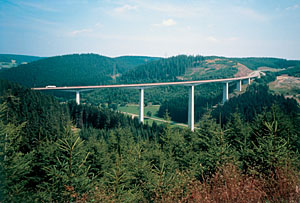Germany Bridges 90 to 100 meters
Engineered by ‘Building Bridges’ book author Hans Wittfoht, the Gutachtalbrücke (97 meters high) is a prestressed concrete beam bridge with 4 mains spans of 331 feet (101 mtrs). Completed in 1980, it was one of Germany’s first high viaducts to have haunched beams instead of the equal depth girders that are on most of the previous German viaducts from the 1960s and 70s.
The tallest bridge of its type in the world when it was completed, the 1968-built Elztalbrücke (97 meters high) near Kehrig consists of 10 piers, each topped with a mushroom deck that cantilevers out from the pier in all directions. Each of these 30 x 24 meter square-like platforms is supported on an octagonal shaped pier. Between each ‘mushroom’ is a simple slab. Since the spans must always be relatively short, there is little advantage to using the mushroom bridge for most tall viaducts. This type of bridge is often used for low level, big city viaducts where the highways are often very wide but there is little room underneath for pier placement.
One of Germany’s first mega sized autobahn viaducts, the 1968-built Grenzwald viaduct (96 meters high) may be more than 40 years old but it still retains wonderful views of a simple, scenic Bavarian valley near Speicherz.
Another large autobahn arch, the Neckarburg bridge (95 meters high) is notable for the larger than usual 42 foot (13 mtr) gap between the top of the arch and the underside of the road deck. Completed in 1977, the main span is 507 feet (154.4 mtrs) and was constructed by a series of stays that were held back by the piers and anchored to the ground at different levels. Not to be confused with the huge Neckar Valley beam bridge 20 miles (32 kms) to the north near Weitingen and also on the A81.
One of the longest concrete arch bridges in Germany, the Kylltalbrucke (93 meters high) has a main span of 732 feet (223 mtrs) on the A60 Autobahn near Badem. The twin ribs and the long spandrel spans of 34 and 50 meters give the structure a light, slender look. Constructed using a series of stays and temporary towers, the bridge was completed in 1999.
One of the largest viaducts in the world to have a wishbone or broken arch for the main span, the Rombachtalbrücke (93 meters high) near Schlitz is the tallest high speed railway bridge in Germany. The main arch was constructed through the use of temporary stays and measures 381 feet (116 mtrs). The smaller spans are all 190 feet (58 mtrs). The Rombachtalbrücke was completed in 1989 on the line between Hanover and Würzburg. The second highest bridge on the line is the Fuldatalbrücke Morschen (75 meters high) which also has a broken arch center support of 381 feet (116 mtrs). Spain’s Rio Deza concrete viaduct is an even higher and larger version of the same bridge type with a main span of 492 feet (150 mtrs) and a height of 348 feet (106 mtrs). On the same Spanish line, a wishbone strut support was also used on the Viaducto de O Eixo.
I never could find its location but the late 1960s viaduct known as Tiefenbachtal (92 meters high) is an early German highway viaduct with 7 steel girder spans of 172 feet (52.5 mtrs). Anyone know the location?
The Lösterbachtalbrücke (90 meters high) was one of Germany’s highest Autobahn bridges when it opened in 1974. Located near Nonnweiler, Germany, the 4-lane structure is reported by some sources to be over 100 meters high. The wide, single 4-lane deck is largely supported by struts that connect to the main box beam core.
Another early autobahn viaduct, the 1977 constructed Eschachtalbrücke (90 meters high) is located near Wildenstein on the A81. The central box beam is 30 feet wide (9 mtrs) and supports a deck 102 feet (31 mtrs) wide. The two main spans are 420 feet (128 mtrs) and 407 feet (124 mtrs) long.
Crossing high above the small German town of Horschel is the Werratal brücke (90 meters high). Located on the A4 autobahn, the steel box girder beam bridge consists of at least a dozen towering piers that mark the southern border of the huge Naturpark Eichsfeld-Hainich-Werratal which generally follows the Werra River.
The Talbrücke Albrechtsgraben (80 meters high) is the smaller brother of the larger Wilde Gera arch bridge located just down the highway on Germany’s state of the art new A71 autobahn. Both bridges cross deep valleys in the Thuringian Forest region. The main span is 513 feet (156.5 mtrs) and supports a thin deck consisting of a trapezoidal steel trough and a simply reinforced concrete slab. On a cost per mile basis, the A71 is the most expensive highway ever built in Germany. The Rennsteig tunnel is also on the A71. At 5 miles (8 kms) in length, it is the longest road tunnel in Germany.
The A81 was one of Germany’s earliest high bridge autobahns. The Jagsttalbrücke (80 meters high) near Widdern is a perfect example. The simple piers support a 98 foot (30 mtr) wide deck cantilevered out on struts supported by a 17 foot (5.25 mtr) deep steel box beam. The bridge was completed in 1974.
